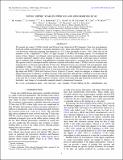YOUNG “DIPPER” STARS IN UPPER SCO AND OPH OBSERVED BY K2
Author(s)
Ansdell, M.; Gaidos, E.; Jacobs, T. L.; LaCourse, D. M.; Jek, K. J.; Mann, A. W.; Wyatt, M. C.; Kennedy, G.; Williams, J. P.; Boyajian, T. S.; Rappaport, Saul A; ... Show more Show less
DownloadAnsdell-2016-YOUNG _DIPPER_ STARS.pdf (2.580Mb)
PUBLISHER_POLICY
Publisher Policy
Article is made available in accordance with the publisher's policy and may be subject to US copyright law. Please refer to the publisher's site for terms of use.
Terms of use
Metadata
Show full item recordAbstract
We present ten young ([< over ~]10 Myr) late-K and M dwarf stars observed in K2 Campaign 2 that host protoplanetary disks and exhibit quasi-periodic or aperiodic dimming events. Their optical light curves show ~10–20 dips in flux over the 80-day observing campaign with durations of ~0.5–2 days and depths of up to ~40%. These stars are all members of the ρ Ophiuchus (~1 Myr) or Upper Scorpius (~10 Myr) star-forming regions. To investigate the nature of these "dippers" we obtained: optical and near-infrared spectra to determine stellar properties and identify accretion signatures; adaptive optics imaging to search for close companions that could cause optical variations and/or influence disk evolution; and millimeter-wavelength observations to constrain disk dust and gas masses. The spectra reveal Li i absorption and Hα emission consistent with stellar youth (<50 Myr), but also accretion rates spanning those of classical and weak-line T Tauri stars. Infrared excesses are consistent with protoplanetary disks extending to within ~10 stellar radii in most cases; however, the sub-millimeter observations imply disk masses that are an order of magnitude below those of typical protoplanetary disks. We find a positive correlation between dip depth and WISE-2 (Wide-field Infrared Survey Explorer-2) excess, which we interpret as evidence that the dipper phenomenon is related to occulting structures in the inner disk, although this is difficult to reconcile with the weakly accreting aperiodic dippers. We consider three mechanisms to explain the dipper phenomenon: inner disk warps near the co-rotation radius related to accretion; vortices at the inner disk edge produced by the Rossby Wave Instability; and clumps of circumstellar material related to planetesimal formation.
Date issued
2016-01Department
Massachusetts Institute of Technology. Department of Physics; MIT Kavli Institute for Astrophysics and Space ResearchJournal
The Astrophysical Journal
Publisher
IOP Publishing
Citation
Ansdell, M., E. Gaidos, S. A. Rappaport, T. L. Jacobs, D. M. LaCourse, K. J. Jek, A. W. Mann, et al. “YOUNG ‘DIPPER’ STARS IN UPPER SCO AND OPH OBSERVED BY K2.” The Astrophysical Journal 816, no. 2 (January 12, 2016): 69. © 2016 The American Astronomical Society
Version: Final published version
ISSN
1538-4357
0004-637X